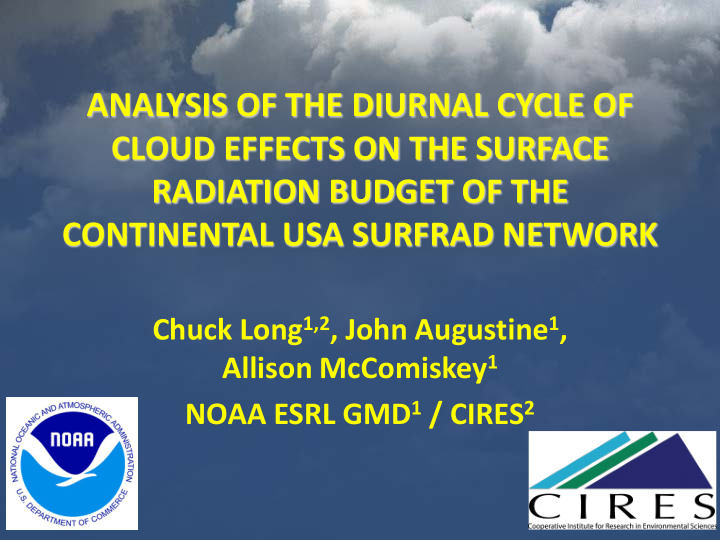



ANALYSIS OF THE DIURNAL CYCLE OF CLOUD EFFECTS ON THE SURFACE RADIATION BUDGET OF THE CONTINENTAL USA SURFRAD NETWORK Chuck Long 1,2 , John Augustine 1 , Allison McComiskey 1 NOAA ESRL GMD 1 / CIRES 2
SURFRAD Network Full surface net radiation budget and basic meteorological measurements N S
Radiative Flux Analysis (RadFlux) • Flux Analysis methodology – Time series analyses of surface broadband radiation and meteorological measurements (T/RH/Wspd) • Need at least 5-minute resolution – Detect clear (cloud free) sky occurrences – Use detected clear sky data to fit functions – Interpolate coefficients to produce continuous estimate of clear-sky irradiances – Use results to infer cloud effects on surface radiation and cloud properties
Cloud Radiative Effect and Forcing • We define the difference between measured and clear-sky downwelling irradiance as the “ downwelling cloud radiative effect ” (CRE). – All-sky – Clear-sky • We define the difference between measured and clear-sky net irradiance (up & down) as the “ cloud radiative forcing ” (CRF). – Alternately the CRE dn - CRE up • With this convention, a positive number is an INCREASE in energy input to the surface caused by clouds, negative is a DECREASE.
Seasonal Diurnal Analysis • Seasons defined as: – Winter: December, January, February (DJF) – Spring: March, April, May (MAM) – Summer: June July, August (JJA) – Fall: September, October, November (SON) • Diurnal Cycle calculated by: – For each season, take average in 15-minute bins across the 24-hour day based on local standard time – Total season average is then average of the average diurnal cycle
Seasonal Average CRE Example • Overall LW CRE magnitude is less than SW CRE magnitude • Goodwin Creek SW CRE always greater magnitude than LW CRE • But for Fort Peck, winter SW CRE is smaller magnitude than LW CRE LW SW
Seasonal Average CRF Example Adding the upwelling CRE gives the • Cloud Radiative Forcing Southern-most Goodwin Creek Net • CRF always remains negative: SW dominates budget and cloud forcing But for northern-most Fort Peck, • winter net CRF is most often positive LW SW Net
Yearly Seasonal Diurnal Examples • Winter cloud amounts are slightly greater at Table Mountain than Desert Rock • Amounts do not exhibit any significant diurnal signature • LW cloud amount less than SW, is indication of the amount of high cloudiness LW SW
Yearly Seasonal Diurnal Examples • Winter cloud amounts produce similar CRF at Table Mountain and Desert Rock • Net CRF is positive during night, but then negative during day when SW dominates LW SW Net
Yearly Seasonal Diurnal Examples • Summer cloud amounts at Desert Rock are less than Winter amounts • Still no significant diurnal signature at Desert Rock • Table Mountain shows much greater cloudiness in afternoon Winter ~35% Summer ~15% LW SW
Yearly Seasonal Diurnal Examples • Desert Rock summer direct and diffuse SW show only modest differences from clear-sky • Table Mountain shows decreased all-sky direct SW and increased diffuse SW in afternoon • Peak all-sky SW occurs at 10:30 am local Average Seasonal Diurnal Cycle: take the average of all the yearly average diurnal cycles.
Average Seasonal Diurnal Cycles • Table Mountain afternoon cloudiness increase also exhibited a little in fall and a bit more in spring • The cloud radiative forcing reflects this seasonal diurnal cloudiness signature Winter Spring Summer Fall
Average Seasonal Diurnal Cycles All Sites Cloud Amount Spring Fall Desert Rock consistently has the least cloudy skies Penn State the most cloudy. Winter and Summer exhibit the greatest Winter Summer differences between sites, transition seasons the least differences .
Average Seasonal Diurnal Cycles All Sites Net Radiation Budget Fall Spring DRA consistently has most negative night time net radiation due to energy loss to the least cloudy skies. Summer Summer Latitude effect is greater Winter Winter & Spring DRA less cloudy
Average Seasonal Diurnal Cycles All Sites Cloud Radiative Forcing Fall Spring DRA has the least daylight Cloud Radiative Forcing for Spring, Summer, and Fall. Sioux Falls and Fort Peck (northernmost) have least daylight CRF for Winter; Goodwin Creek Winter (southernmost) the most. Summer
Summary • SURFRAD sites sample the complete surface radiative energy budget for 7 major US climate regimes • Data are processed through the RadFlux methodology to produce value added products for all sites • http://www.esrl.noaa.gov/gmd/grad/surfrad/index.html • We have produced analyses of the seasonal average diurnal cycles • Sites exhibit differences in surface radiation budget, cloudiness, and cloud radiative effects as an interplay of various factors • Next: • Investigate seasonal & diurnal trends across the years • GMD Baseline Observatories Thanks for listening… Chuck.Long@noaa.gov
Following is extra
Radiative Flux Analysis
Recommend
More recommend